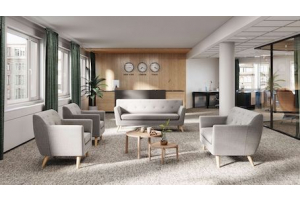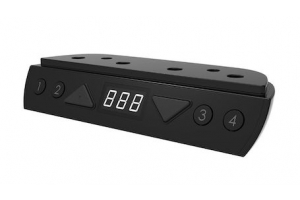5 Best Woods for Your Desk Surface
Here are the best woods for desk surfaces.
Oak

There’s no denying that oak desks are a classic choice. Hardwearing, durable, and relatively easy to work with, oak will not crack under the pressure of screws, nails and sawing. Oak’s a great choice if you’re adapting your desk or opting for a DIY build.
Another key benefit of oak is the flexibility it offers, coming in a range of natural varieties. American white oak is pale, while European oak has a golden brown tone, and red oak is warm and distinctive. Oak can also be stained to match whatever your office style may be.
However, all of this comes at a price. Whilst oak is not the most expensive option, it certainly is not the cheapest. Another drawback is the weight of oak desks, which are on the heavier end of the scale.
Oak also requires some maintenance to maximise its potential for longevity. However, what you put in you get back tenfold, and a bit of TLC can make it last a lifetime. In this respect, oak is a great option for the discernible, sustainable buyer.
Walnut

Oak’s darker, moodier cousin; walnut will fit right in if you’re going for a darker, classic look. Think gothic offices with dark leather upholstery and chic styling. Hardwearing and durable, walnut desks stand the test of time, although it should be noted that the characteristic darker colour of a walnut desk can fade over time.
Walnut does not warp or chip easily and is resistant to both water and mould. A walnut desk can take (almost) anything you throw at it, perfect for long days and tight deadlines when the coffee cups and paperwork pile up high.
That doesn’t mean walnut desks don’t need to be looked after; look after your walnut desk and treat it to an annual re-seal and you will be rewarded with a beautiful, long lasting desk. This longevity is reflected in the cost, however, so be prepared to part with more of your pennies if you opt for a walnut desktop.
Maple

A solid contender for a budget option, maple not only looks good, it lasts. The lighter tones coupled with maple’s straight grain, provide a more modern finish. However, maple can be difficult to work with, so probably not one to spring for if you’re planning to create your dream desk from scratch.
Nonetheless, maple is lightweight, making it a great option for anyone who likes to switch up their office layout for a change of scenery every now and again. Maple also comes in a range of species, offering variety to suit a range of tastes – including Japanese, Norway, sycamore, field, red, and sugar maple.
Cherry

If you’re looking to go bold with your office furniture, then cherry’s distinctive reddish tone may be the one for you. Cherry is another durable, resilient option that isn’t susceptible to rot or decay. However, cherry isn’t scratch resistant, so some care is needed.
Cherry is also great to work with if you’re opting for a DIY project – especially if you’re a newcomer to woodworking and looking for a great entry point to tailor a desktop to truly make it your own.
Pinewood

If cost is your main concern, look no further than pinewood, which is not only cheaper to buy but also to maintain. Light in colour, pinewood is characterised by a creamy white tone; although variety is present across types. The light colour makes it a perfect base for a range of stains, or indeed wood paints, for a customisable desk to suit your style.
Whilst not a hardwood, pine is stiff and highly resistant to shock, shrinking and swelling. Pinewood is also very easy to work with, and another great lightweight option.
However, the old adage ‘you get what you pay for is true here, with pinewood’s increased susceptibility to signs of wear and tear. This makes it more likely that you will have to replace your desk sooner than some hard wearing options.
Is plywood good for a desktop?
Whilst not technically a ‘wood’, plywood is a popular budget choice for desktops as it has low moisture content and offers flexibility in finishing options. However, plywood is also weaker and less durable than wood.
Plywood is also not water resistant, so if you’re prone to spills at your workstation, it’s best to avoid plywood. Similarly, if you’re opting to stain or paint your plywood desk, care must be taken, as if this isn’t done well, it can peel easily.
In all, plywood is cheap, versatile and widely available, making it a great accessible option. However, remember the famous saying: ‘buy cheap, buy twice.



